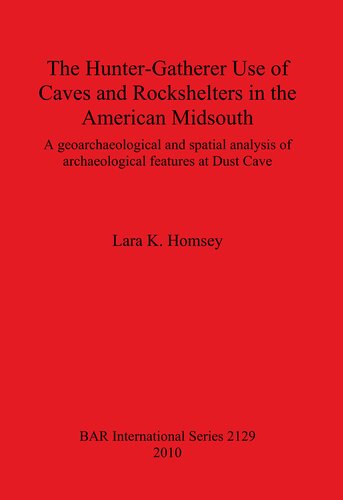

Most ebook files are in PDF format, so you can easily read them using various software such as Foxit Reader or directly on the Google Chrome browser.
Some ebook files are released by publishers in other formats such as .awz, .mobi, .epub, .fb2, etc. You may need to install specific software to read these formats on mobile/PC, such as Calibre.
Please read the tutorial at this link: https://ebookbell.com/faq
We offer FREE conversion to the popular formats you request; however, this may take some time. Therefore, right after payment, please email us, and we will try to provide the service as quickly as possible.
For some exceptional file formats or broken links (if any), please refrain from opening any disputes. Instead, email us first, and we will try to assist within a maximum of 6 hours.
EbookBell Team

4.0
16 reviewsThis study investigates the form, function, and organization of features at the Late Paleoindian through Middle Archaic site of Dust Cave, Alabama (US), using a multidisciplinary approach combining macromorphological, micromorphological, and chemical analyses. Previous studies have relied on observations made at the macroscopic level using morphological and/or content attributes, severely masking the diversity of activities they represent. A more robust method conceptualizes features as sedimentary deposits and reconstructs their depositional history as a means of identifying feature function. At Dust Cave, an integrated method combining micromorphology and geochemistry with more traditional studies of morphology and content highlights the importance of several activities not previously recognized, including broiling, smoking, nut processing, storage, and refuse disposal. Use of Dust Cave as a place in the hunter-gatherer landscape of the Middle Tennessee Valley did not remain constant through time, but rather changed over the millennia. During the Late Paleoindian and early Early Archaic, Dust Cave functioned as a short term residential camp which was occupied fairly intensively during the late summer through fall. During the late Early Archaic, the site shifted to a residential base camp. During the Middle Archaic, the site shifted again to a logistical extraction camp where groups processed hickory nuts on such a large scale that the copious amounts of refuse generated give one the impression of a longer term base camp. The changes seen at Dust Cave mirror changes at other regional cave and rockshelter sites at which numerous nut processing pits, nutting stones, and enormous quantities of nut charcoal indicate a general shift in site use as plant extraction camps—sites where nuts were boiled and parched for transport to base camps located at lower elevations. The increased reliance on mast resources corresponds to warming and drying associated with the middle Holocene. These vegetation changes played a key role in the increasingly logistical mobility strategy of Middle Archaic hunter-gatherer groups.